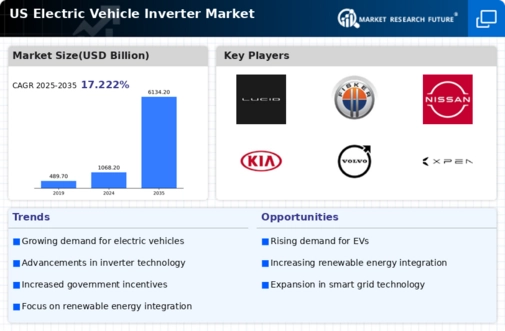Consumer Awareness and Education
Rising consumer awareness regarding the benefits of electric vehicles is a pivotal driver for the electric vehicle-inverter market. As individuals become more informed about the advantages of EVs, including lower operating costs and environmental benefits, the demand for related technologies, such as inverters, increases. Educational initiatives and marketing campaigns are playing a vital role in shaping consumer perceptions. By 2025, it is estimated that consumer knowledge about EV technologies will lead to a 25% increase in inverter sales. This heightened awareness is expected to stimulate growth in the electric vehicle-inverter market, as more consumers seek to invest in sustainable transportation solutions.
Advancements in Battery Technology
Innovations in battery technology are significantly influencing the electric vehicle-inverter market. Enhanced battery performance, including increased energy density and faster charging capabilities, necessitates the development of compatible inverters. In 2025, the US battery market is expected to reach $30 billion, with a substantial portion allocated to EV applications. These advancements not only improve vehicle range but also require sophisticated inverter systems to manage energy flow efficiently. As battery technologies evolve, the electric vehicle-inverter market must adapt, creating opportunities for manufacturers to innovate and enhance their product offerings.
Rising Demand for Electric Vehicles
The increasing consumer preference for electric vehicles (EVs) is a primary driver for the electric vehicle-inverter market. As more individuals opt for EVs, the need for efficient inverters, which convert DC power from batteries to AC power for electric motors, becomes critical. In 2025, the EV market in the US is projected to grow by approximately 30%, leading to a corresponding rise in inverter demand. This growth is fueled by heightened environmental awareness and the desire for reduced carbon footprints. Consequently, manufacturers are focusing on developing advanced inverter technologies to meet this burgeoning demand, thereby propelling the electric vehicle-inverter market forward.
Increased Focus on Energy Efficiency
The growing emphasis on energy efficiency in the automotive sector is a significant driver for the electric vehicle-inverter market. Consumers and manufacturers alike are prioritizing technologies that minimize energy loss during power conversion. In 2025, energy-efficient inverters are projected to account for over 60% of the market share, reflecting a shift towards sustainable practices. This trend is further supported by regulatory frameworks that encourage the adoption of energy-efficient technologies. As a result, the electric vehicle-inverter market is likely to witness a surge in demand for products that meet these efficiency standards.
Infrastructure Development for EV Charging
The expansion of EV charging infrastructure is a crucial factor driving the electric vehicle-inverter market. As the US government and private sectors invest heavily in charging stations, the demand for efficient inverters to support these systems increases. By 2025, the number of public charging stations is anticipated to double, necessitating the integration of advanced inverter technologies to optimize energy distribution. This infrastructure growth not only supports the adoption of EVs but also enhances the overall efficiency of the electric vehicle-inverter market, as reliable charging solutions become essential for consumers.


























Leave a Comment